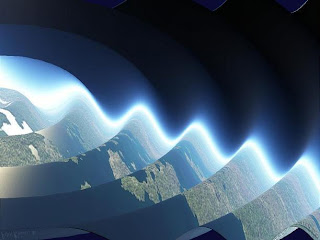All About Microwave:
How does a Microwave Work ?
The microwave oven consists of a magnetron tube, which converts electricity into high frequency microwaves. Microwaves are a form of electromagnetic energy, like light waves or radio waves, and occupy a part of the electromagnetic spectrum. Microwaves cause food molecules to vibrate rapidly, creating friction that produces heat which then cooks the food. In other words, food cooked in a microwave simply absorbs microwave and turns their energy into thermal energy, which cooks the food. Microwaves are colourless, odourless, tasteless, and these are not radioactive.
Microwave oven is one of the most energy efficient appliances money can buy today. For example, it takes 18 times the electricity to bake a potato in a regular oven than in a microwave. Microwaves cook from the outside towards the center of the food.
Microwave ovens are faster for most cooking jobs because the energy heats the food and not the oven or the containers. They don't also heat up the kitchen, especially in the summer time like the other cooking appliances.
When was microwave first used to cook food ?Microwaves were used during World War II as the basis for radars to detect and locate enemy aircrafts at long distances. During this time (ie) in 1945, it was accidentally discovered by an American engineer Percy Le Baron Spencer who was working with radar equipment and noticed that some candy he had in his pocket had melted. Spencer realized that it was these microwaves that had heated the candy and his body too ! He worked for Raytheon at that time, and they soon realized the potential of this discovery, and produced the first household microwave oven.
Can microwaves hurt you ?A small amount of microwaves won't hurt you. Microwaves are anyways present all around us, in the form of satellite transmissions, cellular telephones, and even by the thermal radiation from our surroundings. A properly constructed microwave does not leak any microwaves.
Why can't I use a metal container in a microwave ?Microwaves causes currents to flow in metals, these currents may heat the metal hot enough to cause a fire. Therefore, it is not a good idea to use metal containers in a microwave.
Time required to boil 8 ounces of room temperature (about 75F) water:
The higher the wattage of the microwave the faster the microwave cooks.
850 - 1000 watts - takes less than 2 minutes650 - 850 watts - takes 2 - 3 minutes or less400 - 650 watts - takes 3 - 4 minutes or less
Microwave tips to remember:
Do not use metal pots and pans, or metal utensils.
Food is completely cooked if the bottom of plate feels warm in the center.
Cook small foods, under 2 inches in diameter, for less time, since the heat penetrates more quickly from all sides.
To prevent food from drying out, cover the food with a vented cover whenever cooking or re-heating.
Always use less salt and seasoning than normal when cooking in the microwave, since this draws out the moisture and will toughen the food. Add the salt later in the cooking process.
Use less water when microwaving, due to the shorter cooking time.
Stir liquids periodically when microwaving, and stir the outer sections, which cook faster, into the center of the dish and center sections to the outside. This equalizes the temperature throughout the food.
Cook dense food for more time in the microwave, since dence food cooks slower than porous food.
Arrange food with thickest parts, and bulky vegetables on outside of plate and quick-to-heat less-dense foods in the center. Spread a single serving of a main dish in an even layer on plate.
Turn large food over occasionally in the microwave, for more even cooking.
Microwave cooked food require some standing time, since they continue to cook for a few minutes after they are removed from the microwave oven. Cover this food with plate, waxed paper or paper towel to direct the heat back into the food.
Make sure not to block the vents of the microwave oven, or the oven will overheat
http://www.sysindia.com/kitchen/microwave.htmlHistory of Microwave
The microwave oven did not come about as a result of someone trying to find a better, faster way to cook. During World War II, two scientists invented the magnetron, a tube that produces microwaves. Installing magnetrons in Britain’s radar system, the microwaves were able to spot Nazi warplanes on their way to bomb the British Isles.
By accident, several years later, it was discovered that microwaves also cook food. Called the Radar Range, the first microwave oven to go on the market was roughly as large and heavy as a refrigerator.The idea of using microwave energy to cook food was accidentally discovered by Percy LeBaron Spencer of the Raytheon Company when he found that radar waves had melted a candy bar in his pocket. Experiments showed that microwave heating could raise the internal temperature of many foods far more rapidly than a conventional oven. Microwave OvenThe first Raytheon commercial microwave oven was the 1161 Radarange, which was marketed in 1954. Rated at 1600 watts, it was so large and expensive that it was practical only for restaurant and institutional use.
In 1967, Amana, a division of Raytheon, introduced its domestic Radarange microwave oven, marking the beginning of the use of microwave ovens in home kitchens. Although sales were slow during the first few years, partially due to the oven’s relatively expensive price tag, the concept of quick microwave cooking had arrived. In succeeding years, Litton and a number of other companies joined the countertop microwave oven market. By the end of 1971, the price of countertop units began to decrease and their capabilities were expanded.
All electromagnetic energy can be characterized as waves with a specific wavelength and frequency distributed over a continuous range known as the electromagnetic spectrum. For example, some radio waves have a wavelength of 6 feet (12 meters) and a frequency of 50 million hertz (Hz-cycles per second). Visible light waves have a wavelength of 400 to 700 millimicrons, and typical X-rays have a length of 0.01 millimicrons and a frequency of 30 x 10¹² millions.
Microwaves (short waves or high frequency radio waves) are the shortest of radio waves, with a length of 0.1 millimeter and a frequency of 3 x 109 Hz. They are found in the non-ionizing portion of the energy spectrum, between radio waves and visible light. "Non-ionizing" means that microwaves do not detach charged particles and produce atoms with an unbalanced plus or minus charge. Microwaves can therefore safely produce heat and not cause food to become radioactive.
Microwaves are reflected from most metals but they produce inductive resonance's in the atoms of many other substances. It was the discovery of their reaction to metals that led to the invention of radar. It was their ability to produce resonant coupling that led to the invention of the microwave oven.
How to use it
In microwave cooking, the radio waves penetrate the food and excite water and fat molecules pretty much evenly throughout the food. No heat has to migrate toward the interior by conduction. There is heat everywhere all at once because the molecules are all excited together. There are limits, of course. Radio waves penetrate unevenly in thick pieces of food (they don't make it all the way to the middle), and there are also "hot spots" caused by wave interference, but you get the idea. The whole heating process is different because you are "exciting atoms" rather than "conducting heat."
In a microwave oven, the air in the oven is at room temperature, so there is no way to form a crust. That is why microwavable pastries sometimes come with a little sleeve made out of foil and cardboard. You put the food in the sleeve and then microwave it. The sleeve reacts to microwave energy by becoming very hot. This exterior heat lets the crust become crispy as it would in a conventional oven.
Click this link to download the PowerPoint:
http://rapidshare.com/files/340193365/Untitled_2.ppt.html


